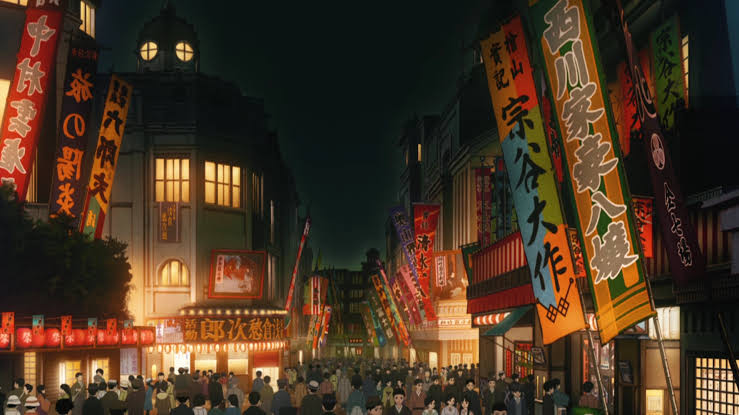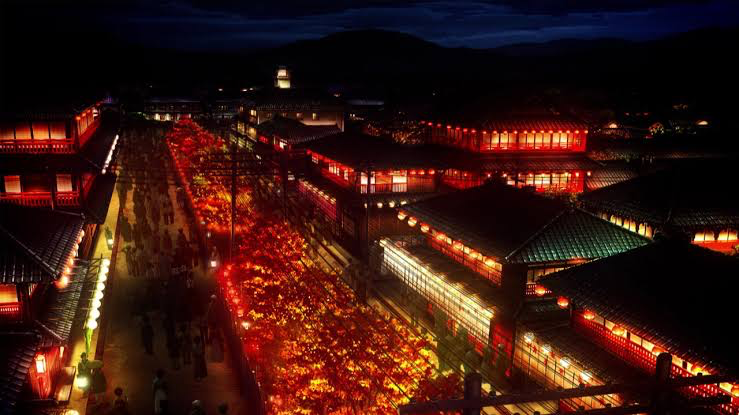The events in Demon Slayer, both in the anime and the original manga, take place during the Taisho era, a time of significant historical and cultural shifts in Japan. Only running for 14 years from July 30, 1912, to December 25, 1926, the Taisho era is one of the shortest in Japanese history, and the plot of Demon Slayer is set during these years.
Aside from demons, the anime makes accurate analogies to how life was at the time of the Taisho era. The setting of Demon Slayer primarily revolves around various locations within Tokyo. While the specific locations in the series are fictional, they draw inspiration from real-life places and landmarks.
During the Taisho era, Japan experienced a considerable transformation. Western influences continued to shape the cultural landscape, resulting in a fusion of traditional Japanese elements and modern Western ideals. This amalgamation is reflected in the setting and themes of Demon Slayer. In Demon Slayer, the main protagonist, Tanjiro Kamado, ventures into a world infested with demons and joins the Demon Slayer Corps, an organization dedicated to eradicating demons and protecting humanity.
What Year Does Demon Slayer Take Place
Although the exact year the Demon Slayer series takes place was not specified or explicitly stated, the timeline of the series, as previously mentioned, is Japan’s Taisho era, which spanned the period of July 1912 – December 1926. The setting and atmosphere of early 20th-century Japan are evoked to create a unique and immersive world for the story of Demon Slayer to unfold.
The events of Demon Slayer align with the cultural and historical context of that time. The series incorporates elements of traditional Japanese aesthetics, architecture, clothing, and societal norms from the early 1900s. The series showcases a mix of rural and urban settings, including forests, mountains, villages, and cities.

The Taisho era was a significant period in Japanese history, marked by a transition from the Meiji era’s rapid modernization to a more culturally vibrant and creative time. During the Taisho era, Japan experienced a blend of traditional Japanese culture and Western influences, shown in Muzan’s non-traditional Japanese attire.
However, it’s important to note that Demon Slayer is a work of fantasy and does not adhere strictly to historical accuracy. The series introduces supernatural elements, such as demons and demon slayers, which exist in a fictionalized version of Japan’s Taisho era.
It was a time of artistic flourishing, with the emergence of new art forms, literature, and entertainment. The era is known for its cultural renaissance, where traditional values intertwined with modern ideas, as depicted in the series.
Demon Slayer Draws From Real-Life Locations
Demon Slayer primarily takes place in various locations across Tokyo, Japan. While the specific locations in the series are fictional, they draw inspiration from real-life places and landmarks.
One notable real-life location that inspired the setting in Demon Slayer is Mount Kumotori. In the series, Mount Kumotori serves as the backdrop for the final selection, a grueling test that potential Demon Slayers must undergo. Mount Kumotori is an actual mountain located on the border of Tokyo and Saitama Prefecture. The lush forests, rugged terrain, and scenic beauty of Mount Kumotori were likely influential in the creation of the final selection setting.

Additionally, the city of Kyoto, a renowned cultural and historical center in Japan, is referenced in the series. Although Demon Slayer does not directly depict Kyoto, it takes inspiration from the city’s traditional architecture, temples, and historical charm.
The setting of the entertainment district in Demon Slayer also takes inspiration from the real-life Yoshiwara area of the Edo period in Japan. Known as the Yukaku, meaning red light district. However, the entertainment district in Demon Slayer is a fictionalized version, allowing for the incorporation of fantasy and anime elements. The original Yoshiwara area was renowned for its historical significance, and the adaptation in Demon Slayer builds upon this foundation, creating a captivating and visually stunning rural setting in the series.
While Demon Slayer’s settings are fictionalized and inspired by real locations, it’s important to note that the series primarily exists within its own fantastical universe. The creators have blended historical elements with supernatural fantasy to create a unique and captivating world.
When Does The Demon Slayer Movie Take Place?
Just like the series Demon Slayer: Kimetsu no Yaiba, the Movie: Mugen Train also takes place in the fictionalized version of the 14-year-long Taisho era in Japanese history. The movie is primarily set on the Mugen Train itself, and the events of the film take place immediately after the conclusion of Season 1 of the anime series. It serves as a direct continuation of the story and adapts the “Mugen Train” arc from the original manga.
The Mugen Train arc is a significant storyline within the Demon Slayer series, bridging the gap between the anime’s first and second seasons. The movie occurs shortly after Tanjiro Kamado, the main protagonist, and his companions, Zenitsu Agatsuma and Inosuke Hashibira, complete their training at the Butterfly Estate and embark on a mission aboard the Mugen Train. The events depicted in the movie are a crucial part of the overall Demon Slayer storyline and contribute to the character development and progression of the plot.
The Mugen Train is a supernatural locomotive that becomes the backdrop for a critical mission undertaken by the main characters. The train serves as a unique and dangerous environment where they encounter various challenges and confront powerful adversaries.

